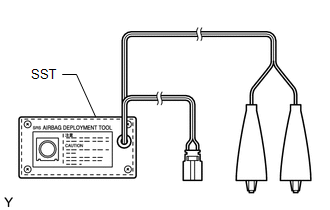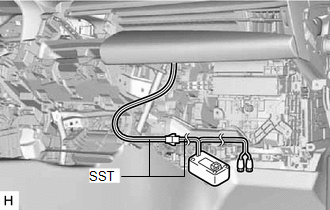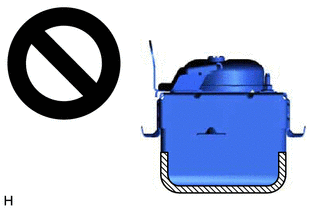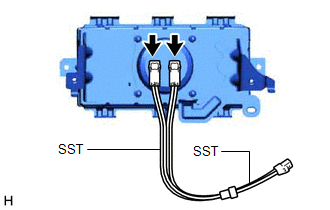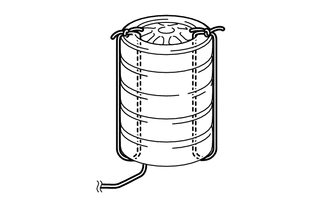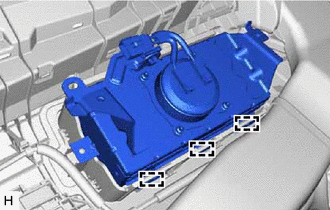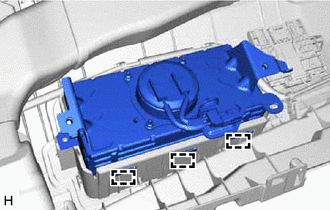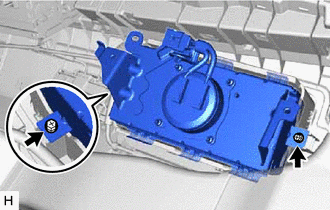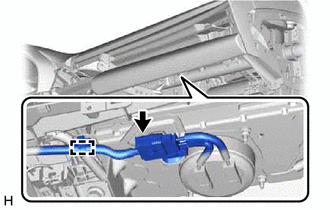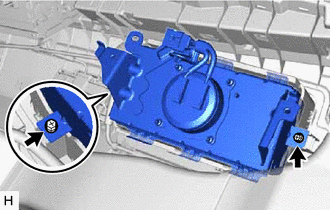Components
COMPONENTS
ILLUSTRATION
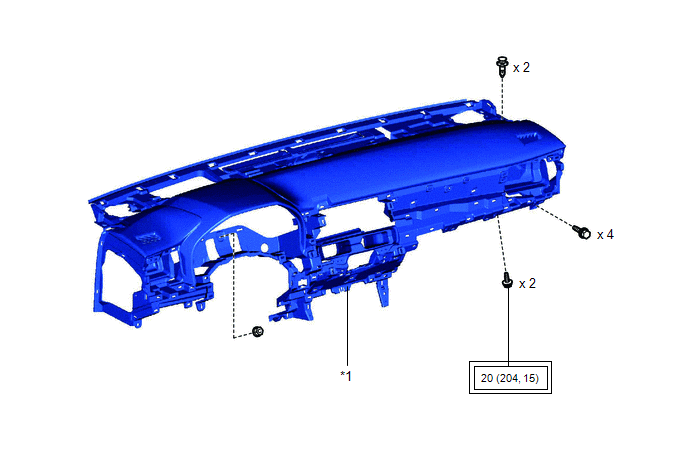
|
*1 | INSTRUMENT PANEL SAFETY PAD SUB-ASSEMBLY |
- | - |
 |
Tightening torque for "Major areas involving basic vehicle performance such as moving/turning/stopping": N*m (kgf*cm, ft.*lbf) |
- | - |
ILLUSTRATION
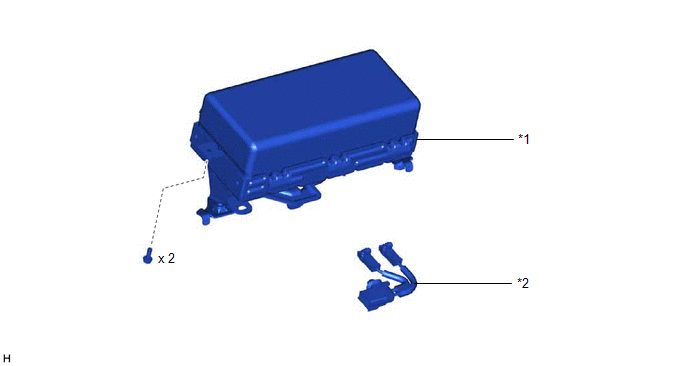
|
*1 | INSTRUMENT PANEL PASSENGER AIRBAG ASSEMBLY |
*2 | NO. 2 INSTRUMENT PANEL WIRE |
Disposal
DISPOSAL
CAUTION / NOTICE / HINT
CAUTION:
Before
performing pre-disposal deployment of any SRS part, review and closely
follow all applicable environmental and hazardous material regulations.
Pre-disposal deployment may be considered hazardous material treatment.
PROCEDURE
1. PRECAUTION
CAUTION:
- An airbag or pretensioner may be accidentally deployed by static
electricity. To prevent this, be sure to touch a metal surface with your
bare hands to discharge static electricity before performing this
procedure.
- Never dispose of an instrument panel passenger airbag assembly with an undeployed airbag.
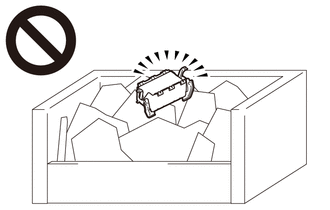
- The airbag produces an exploding sound when it is deployed, so perform
the operation outdoors where it will not disturb nearby residents.
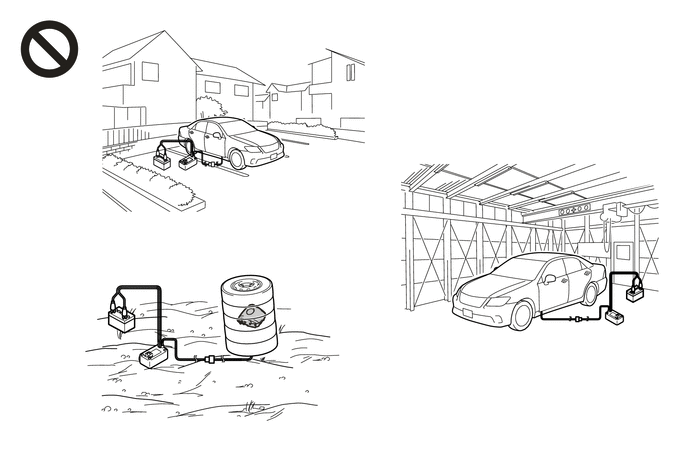
- When deploying the airbag, always use the specified SST (SRS airbag
deployment tool). Perform the operation in a place away from electrical
noise.
- When deploying the airbag, perform the operation at least 10 m (32.8
ft.) away from the instrument panel passenger airbag assembly.
- The instrument panel passenger airbag assembly becomes extremely hot
when the airbag is deployed, so do not touch it for at least 30 minutes
after deployment.
- Use gloves and safety glasses when handling an instrument panel passenger airbag assembly with a deployed airbag.
- Do not apply water, etc. to an instrument panel passenger airbag assembly with a deployed airbag.
- Always wash your hands with water after completing the operation.
HINT:
When
scrapping a vehicle equipped with an SRS or disposing of the instrument
panel passenger airbag assembly, be sure to deploy the airbag first in
accordance with the following procedure. If any abnormality occurs with
the airbag deployment, contact the Service Department of TOYOTA MOTOR
SALES, U.S.A., INC.
2. DISPOSE OF INSTRUMENT PANEL PASSENGER AIRBAG ASSEMBLY (When Installed to Vehicle)
NOTICE:
- When disposing of an instrument panel passenger airbag assembly, never use the customer's vehicle to deploy the airbag.
- Be sure to perform the following procedure when deploying the airbag.
HINT:
Prepare a 12 V battery as the power source to deploy the airbag.
| (a) Check the function of SST. Click here
 SST: 09082-00700 | |
(b) Refer to Precaution.
for Gasoline Model: Click here

for HV Model: Click here

(c) Disconnect the cable from the negative (-) auxiliary battery terminal.
CAUTION:
Wait
at least 90 seconds after disconnecting the cable from the negative (-)
auxiliary battery terminal to disable the SRS system.
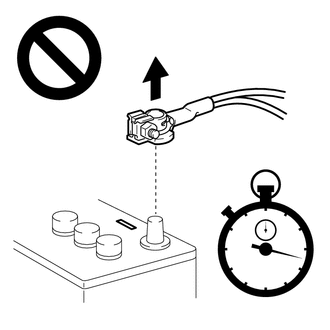
(d) Remove the lower instrument panel sub-assembly.
Click here 
(e) Disconnect the No. 2 instrument panel wire.
Click here 
(f) Install SST.
CAUTION:
Check that there is no looseness in the instrument panel passenger airbag assembly or instrument panel safety pad sub-assembly.
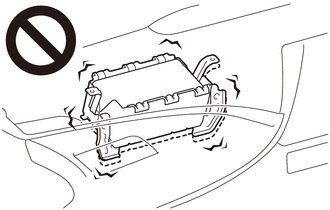
| (1) After connecting the following SST to each other, connect them to the No. 2 instrument panel wire.
NOTICE: To avoid damaging the SST connector or wire harness, do not lock the secondary lock of the twin lock.
SST: 09082-00700 SST: 09082-00780 | |
| (2) Move SST at least 10 m (32.8 ft.) away from the front side window of the vehicle. |
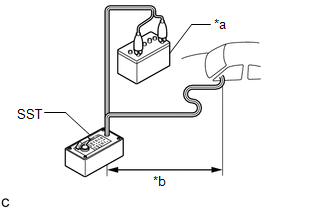 |
|
*a | 12 V Battery | |
*b | 10 m (32.8 ft.) or more | | |
(3)
Maintaining sufficient clearance for the SST wire harness in the front
side window, close all doors and windows of the vehicle.
NOTICE:
Take care not to damage the SST wire harness.
(4)
Connect the red clip of SST to the positive (+) battery terminal and
the black clip of SST to the negative (-) battery terminal.
(g) Deploy the airbag.
(1) Check that no one is inside the vehicle or within a 10 m (32.8 ft.) radius of the vehicle.
(2) Press the SST activation switch to deploy the airbag.
CAUTION:
- Before deployment, make sure that no one is inside or near the vehicle.
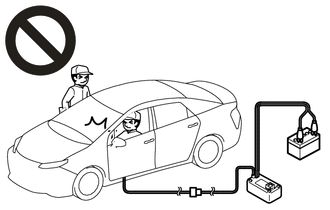
- The instrument panel passenger airbag assembly becomes extremely hot
when the airbag is deployed, so do not touch it for at least 30 minutes
after deployment.
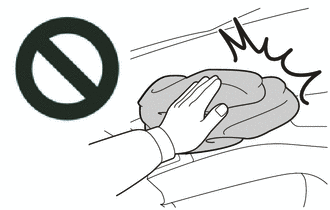
- Use gloves and safety glasses when handling an instrument panel passenger airbag assembly with a deployed airbag.
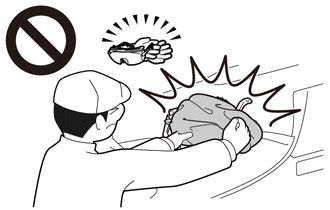
- Do not apply water, etc. to an instrument panel passenger airbag assembly with a deployed airbag.
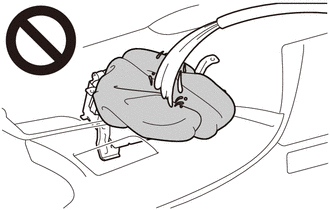
- Always wash your hands with water after completing the operation.
HINT:
The airbag is deployed as the LED of the SST activation switch comes on.
3. DISPOSE OF INSTRUMENT PANEL PASSENGER AIRBAG ASSEMBLY (When not Installed to Vehicle)
NOTICE:
Be sure to perform the following procedure when deploying the airbag.
HINT:
Prepare a 12 V battery as the power source to deploy the airbag.
| (a) Check the function of SST. Click here
 SST: 09082-00700 | |
(b) Remove the instrument panel passenger airbag assembly.
Click here

CAUTION:
(c) Install SST.
|
(1) After connecting the following SST to each other, connect them to the instrument panel passenger airbag assembly.
SST: 09082-00802 09082-10801 09082-30801 | |
(d) Using braided wire, tie down the instrument panel passenger airbag assembly to an unneeded tire.
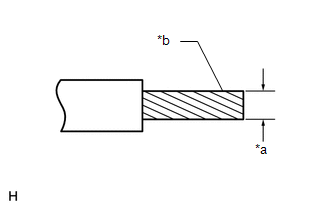
|
*a | Wire Diameter |
|
*b | Stripped Wire Cross Sectional Area |
Wire:
Stripped Wire Cross Sectional Area
1.25 mm2 (0.0019 in.2) or more
CAUTION:
If
the wire is too thin or an alternative object is used to tie down the
instrument panel passenger airbag assembly, it may snap when the airbag
is deployed. Always use a wire for vehicle use with a cross sectional
area of at least 1.25 mm2 (0.0019 in.2).
HINT:
To calculate the cross sectional area of the stripped wire:
Cross sectional area = 3.14 x (Diameter)2 / 4
(1) Position the instrument panel passenger airbag assembly inside the tire with the airbag deployment side facing inward.
Minimum Tire Size:
Width
185 mm (7.28 in.)
Inner Diameter
360 mm (1.18 ft.)
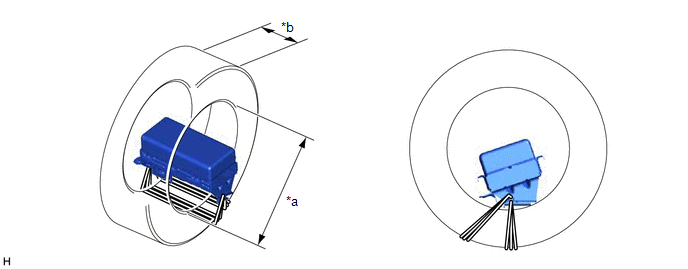
|
*a | Inner Diameter | *b |
Width |
CAUTION:
- Make sure that the wires are tight. If there is slack in the wires, the
instrument panel passenger airbag assembly may break loose when the
airbag is deployed.
- Always tie down the instrument panel passenger airbag assembly with the airbag deployment side facing inside the tire.
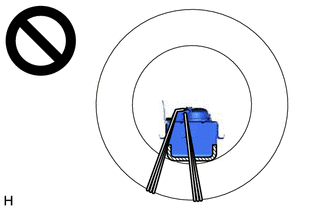
 |
Deployment Side |
NOTICE:
The tire may be damaged by the airbag deployment, so use an unneeded tire.
(e) Place the tires.
| (1) Place at least 2 tires under the tire to which the instrument panel passenger airbag assembly is tied.
Minimum Tire Size: Width 185 mm (7.28 in.) Inner Diameter
360 mm (1.18 ft.) NOTICE: Do not place the SST connector under the tire because it could be damaged. |
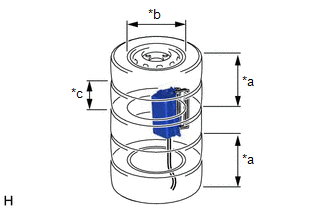 |
|
*a | Tires (2 or more) | |
*b | Inner Diameter | |
*c | Width | | |
(2)
Place at least 2 tires onto the tire to which the instrument panel
passenger airbag assembly is tied. The top tire should have a wheel
installed.
NOTICE:
The wheel and tires may be damaged by the airbag deployment, so use an unneeded wheel and tires.
| (3) Tie the tires together with 2 wires. CAUTION: Make sure that the wires are tight. Looseness in the wires will result in the tires breaking loose when the airbag is deployed. |
|
(f) Install SST.
| (1) Connect the SST connector.
SST: 09082-00700 NOTICE: To
avoid damaging the SST connector or wire harness, do not lock the
secondary lock of the twin lock. Also, secure some slack for the SST
wire harness inside the tire. |
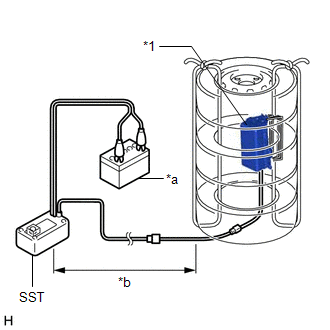 |
|
*1 | Instrument Panel Passenger Airbag Assembly | |
*a | 12 V Battery | |
*b | 10 m (32.8 ft.) or more | | |
(2) Move SST at least 10 m (32.8 ft.) away from the airbag tied down to the tire.
(g) Deploy the airbag.
(1)
Connect the red clip of SST to the positive (+) battery terminal and
the black clip of SST to the negative (-) battery terminal.
(2)
Check that no one is within a 10 m (32.8 ft.) radius of the tire to
which the instrument panel passenger airbag assembly is tied.
(3) Press the SST activation switch to deploy the airbag.
CAUTION:
Before deployment, make sure that no one is near the airbag.
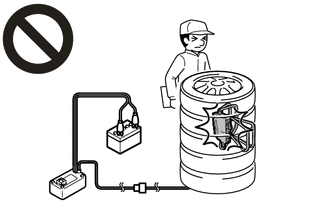
HINT:
The airbag is deployed as the LED of the SST activation switch comes on.
(h) Dispose of the instrument panel passenger airbag assembly.
CAUTION:
- The instrument panel passenger airbag assembly becomes extremely hot
when the airbag is deployed, so do not touch it for at least 30 minutes
after deployment.
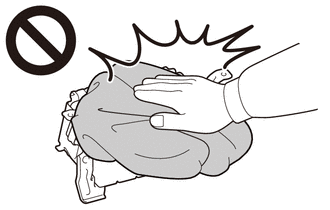
- Use gloves and safety glasses when handling an instrument panel passenger airbag assembly with a deployed airbag.
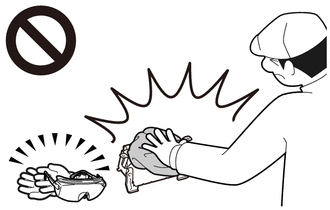
- Do not apply water, etc. to an instrument panel passenger airbag assembly with a deployed airbag.
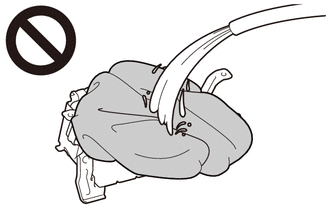
- Always wash your hands with water after completing the operation.
(1) Remove the instrument panel passenger airbag assembly from the tire.
(2)
Place the instrument panel passenger airbag assembly in a plastic bag,
tie it tightly, and dispose of it according to local regulations.
Installation
INSTALLATION
PROCEDURE
1. INSTALL NO. 2 INSTRUMENT PANEL WIRE
(a) Connect the 2 airbag connectors of the No. 2 instrument panel wire to the instrument panel passenger airbag assembly.
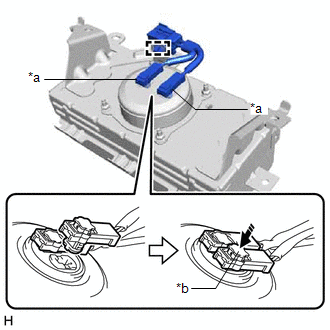
|
*a | Airbag Connector |
|
*b | Airbag Connector Locking Button |
 |
Push in this Direction |
NOTICE:
- When connecting any airbag connector, take care not to damage the airbag wire harness.
- Be sure to only connect the connectors to each corresponding color.
(b) Push in the 2 airbag connector
locking buttons as shown in the illustration to install the 2 airbag
connectors to the instrument panel passenger airbag assembly.
(c) Engage the clamp.
2. INSTALL INSTRUMENT PANEL PASSENGER AIRBAG ASSEMBLY
| (b) Push in the instrument panel passenger airbag assembly to engage the 3 hooks. |
|
| (c) Install the instrument panel passenger airbag assembly with the 2 screws. |
|
3. INSTALL INSTRUMENT PANEL SAFETY PAD SUB-ASSEMBLY
Click here

4. CONNECT NO. 2 INSTRUMENT PANEL WIRE
(a) Check that the engine switch (for Gasoline Model) or power switch (for HV Model) is off.
(b) Check that the cable is disconnected from the negative (-) auxiliary battery terminal.
CAUTION:
Wait
at least 90 seconds after disconnecting the cable from the negative (-)
auxiliary battery terminal to disable the SRS system.
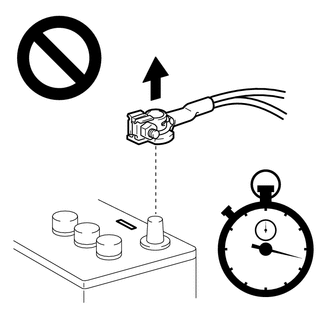
| (c) Connect the connector. NOTICE: When connecting any airbag connector, take care not to damage the airbag wire harness. |
|
(d) Engage the clamp.
5. INSTALL TURN SIGNAL SWITCH
Click here

On-vehicle Inspection
ON-VEHICLE INSPECTION
CAUTION / NOTICE / HINT
CAUTION:
Be sure to correctly follow the removal and installation procedures for the instrument panel passenger airbag assembly.
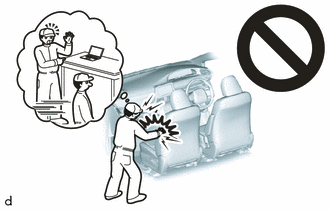
PROCEDURE
1. INSPECT INSTRUMENT PANEL PASSENGER AIRBAG ASSEMBLY (for Vehicle not Involved in Collision)
(a) Perform a diagnostic system check.
for Gasoline Model: Click here

for HV Model: Click here

(b) Visually check for defects with the instrument panel passenger airbag assembly installed to the vehicle.
HINT:
The defects are as follows:
- Cuts on the instrument panel safety pad sub-assembly around the instrument panel passenger airbag assembly
- Small cracks on the instrument panel safety pad sub-assembly around the instrument panel passenger airbag assembly
- Significant discoloration on the instrument panel safety pad sub-assembly around the instrument panel passenger airbag assembly
OK:
No defects are found.
If any defects are found, replace the instrument panel safety pad sub-assembly with a new one.
2. INSPECT INSTRUMENT PANEL PASSENGER AIRBAG ASSEMBLY (for Vehicle Involved in Collision and Airbag not Deployed)
(a) Perform a diagnostic system check.
for Gasoline Model: Click here

for HV Model: Click here

(b) Visually check for defects with the instrument panel passenger airbag assembly removed from the vehicle.
HINT:
The defects are as follows:
- Cuts
- Small cracks
- Significant discoloration
- Cracks or other damage to the connector
- Deformation or cracks on the instrument panel safety pad sub-assembly or instrument panel reinforcement
OK:
No defects are found.
If
any defects are found, replace the instrument panel passenger airbag
assembly, instrument panel safety pad sub-assembly or instrument panel
reinforcement with a new one.
Removal
REMOVAL
CAUTION / NOTICE / HINT
The
necessary procedures (adjustment, calibration, initialization or
registration) that must be performed after parts are removed and
installed, or replaced during instrument panel passenger airbag assembly
removal/installation are shown below.
Necessary Procedures After Parts Removed/Installed/Replaced (for Gasoline Model) |
Replaced Part or Performed Procedure |
Necessary Procedure | Effect/Inoperative Function when Necessary Procedure not Performed |
Link |
|
*: When performing learning using the Techstream.
Click here  |
|
Disconnect cable from negative auxiliary battery terminal |
Perform steering sensor zero point calibration |
Lane Departure Alert System (w/ Steering Control) |
 |
|
Pre-collision System |
|
Intelligent Clearance Sonar System* |
|
Lighting System (for Gasoline Model with Cornering Light) |
|
Memorize steering angle neutral point |
Parking Assist Monitor System |
 |
|
Panoramic View Monitor System |
 |
Necessary Procedures After Parts Removed/Installed/Replaced (for HV Model) |
Replaced Part or Performed Procedure |
Necessary Procedure | Effect/Inoperative Function when Necessary Procedure not Performed |
Link |
|
*: When performing learning using the Techstream.
Click here  |
|
Disconnect cable from negative auxiliary battery terminal |
Perform steering sensor zero point calibration |
Lane Departure Alert System (w/ Steering Control) |
 |
|
Pre-collision System |
|
Intelligent Clearance Sonar System* |
|
Lighting System (for HV Model with Cornering Light) |
|
Memorize steering angle neutral point |
Parking Assist Monitor System |
 |
|
Panoramic View Monitor System |
 |
PROCEDURE
1. PRECAUTION
CAUTION:
Be sure to read Precaution thoroughly before servicing.
for Gasoline Model: Click here 
for HV Model: Click here

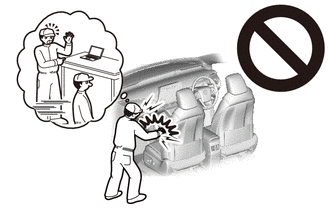
NOTICE:
After
turning the engine switch (for Gasoline Model) or power switch (for HV
Model) off, waiting time may be required before disconnecting the cable
from the negative (-) auxiliary battery terminal. Therefore, make sure
to read the disconnecting the cable from the negative (-) auxiliary
battery terminal notices before proceeding with work.
Click here

2. REMOVE TURN SIGNAL SWITCH
Click here

3. DISCONNECT NO. 2 INSTRUMENT PANEL WIRE
(a) Check that the engine switch (for Gasoline Model) or power switch (for HV Model) is off.
(b) Check that the cable is disconnected from the negative (-) auxiliary battery terminal.
CAUTION:
Wait
at least 90 seconds after disconnecting the cable from the negative (-)
auxiliary battery terminal to disable the SRS system.
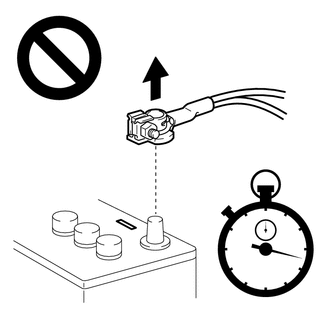
(c) Disengage the clamp.
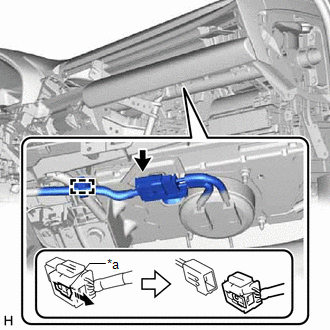
|
*a | Slider |
 |
Release in this Direction |
(d) Slide the slider to release the lock, and then disconnect the connector.
NOTICE:
When disconnecting any airbag connector, take care not to damage the airbag wire harness.
4. REMOVE INSTRUMENT PANEL SAFETY PAD SUB-ASSEMBLY
Click here

5. REMOVE INSTRUMENT PANEL PASSENGER AIRBAG ASSEMBLY
CAUTION:
When storing the instrument panel passenger airbag assembly, keep the airbag deployment side facing upward.
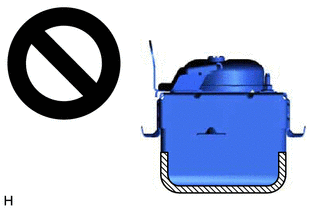
 |
Deployment Side |
(b) Using a screwdriver, pry back the passenger airbag door retainer to disengage the 3 hooks as shown in the illustration.
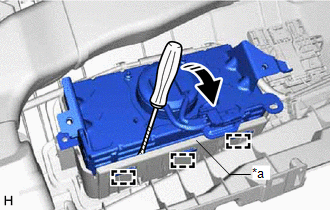
|
*a | Passenger Airbag Door Retainer |
 |
Move the screwdriver in this Direction |
NOTICE:
Do not damage the deployment surface of the instrument panel passenger airbag assembly.
| (c)
Disengage the 3 hooks to remove the instrument panel passenger airbag
assembly from the instrument panel safety pad sub-assembly. | |
6. REMOVE NO. 2 INSTRUMENT PANEL WIRE
(a) Disengage the clamp.
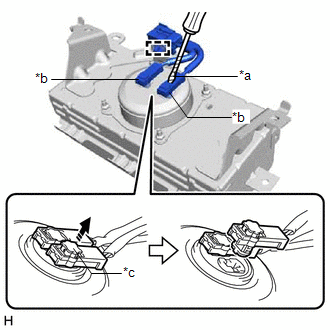
|
*a | Protective Tape |
|
*b | Airbag Connector |
|
*c | Airbag Connector Locking Button |
 |
Release in this Direction |
(b) Using a screwdriver with its tip wrapped with protective tape, release the 2 airbag connector locking buttons.
(c)
Disconnect the 2 airbag connectors to remove the No. 2 instrument panel
wire from the instrument panel passenger airbag assembly.
NOTICE:
When disconnecting any airbag connector, take care not to damage the airbag wire harness.






